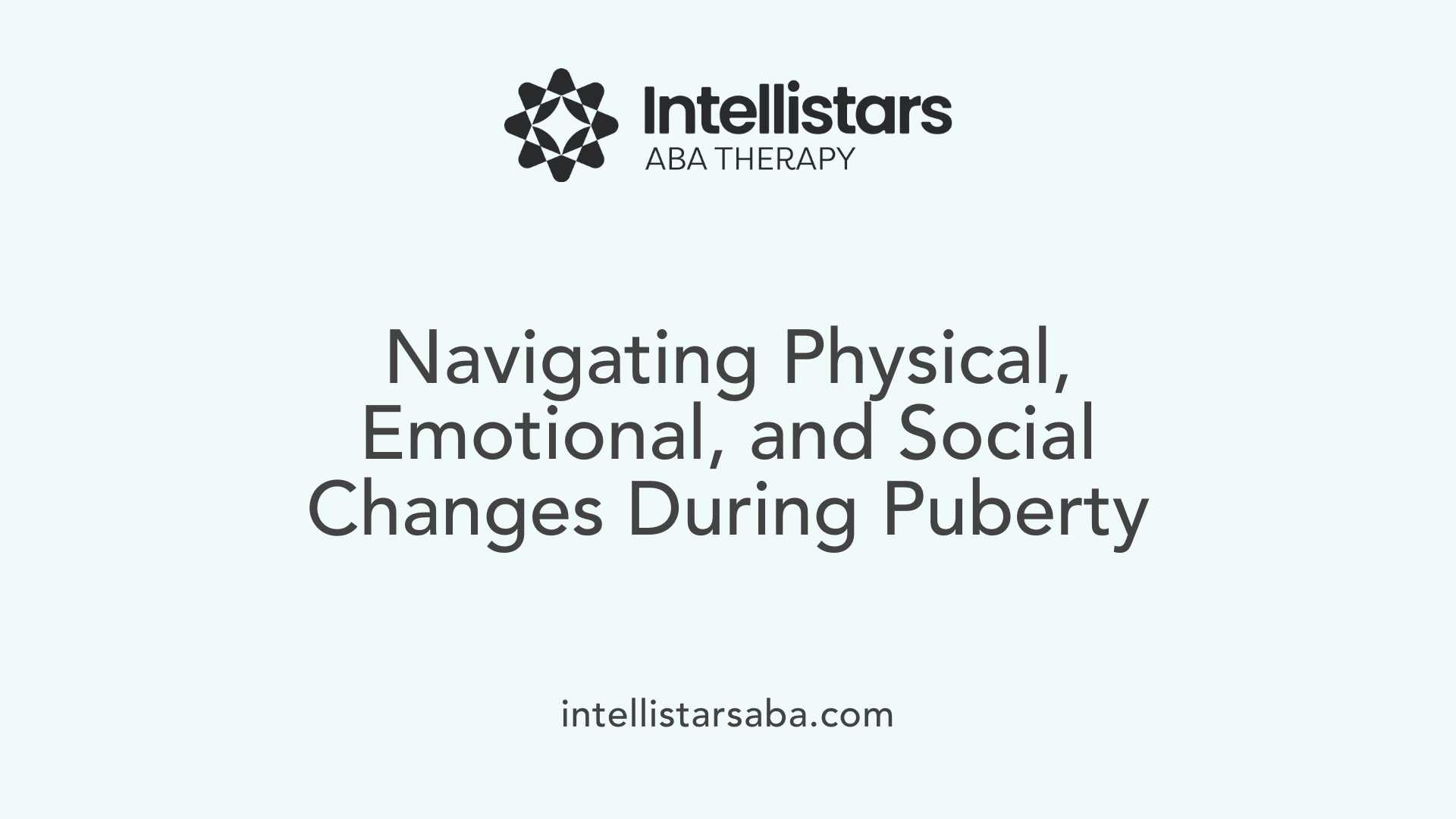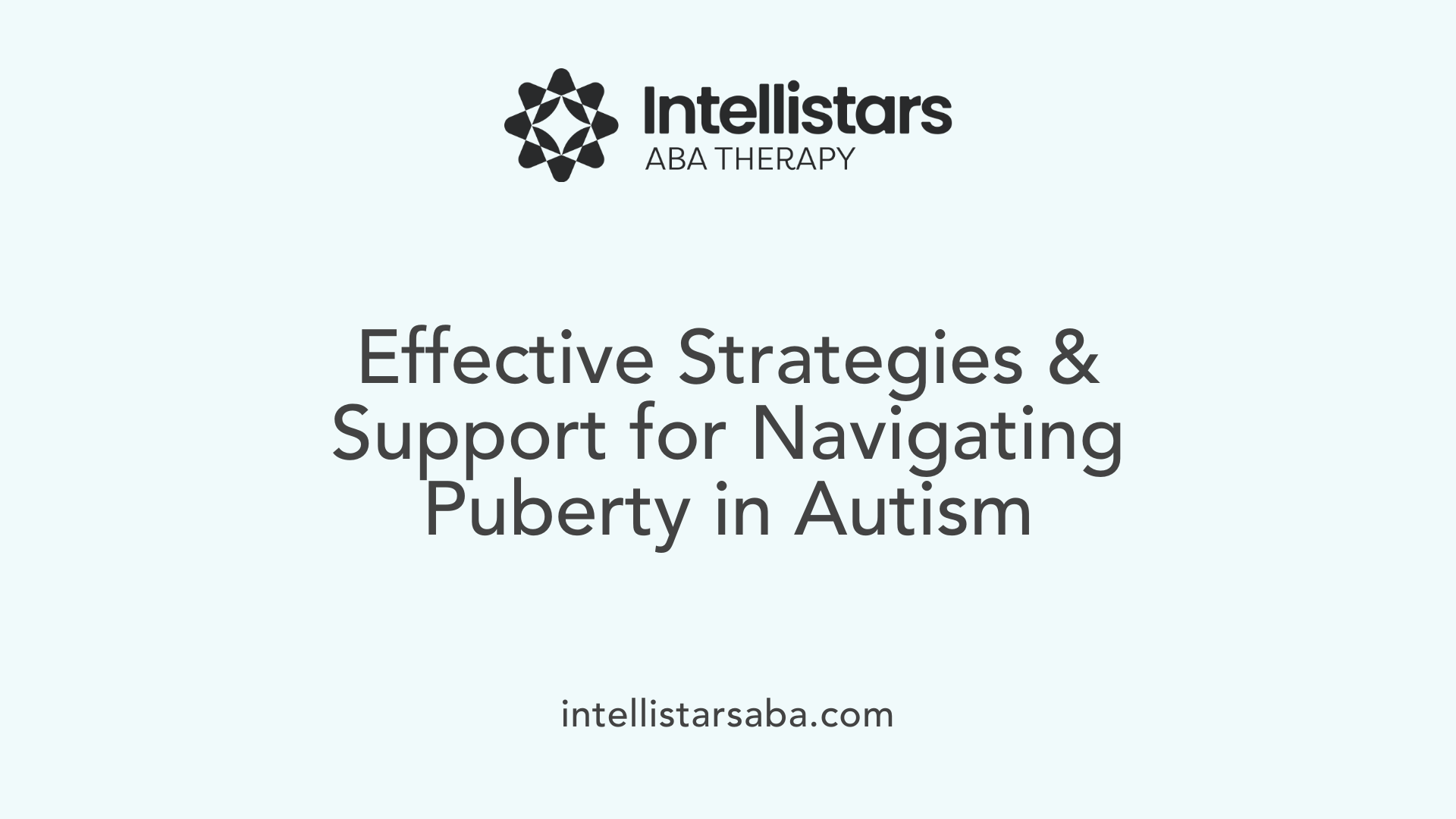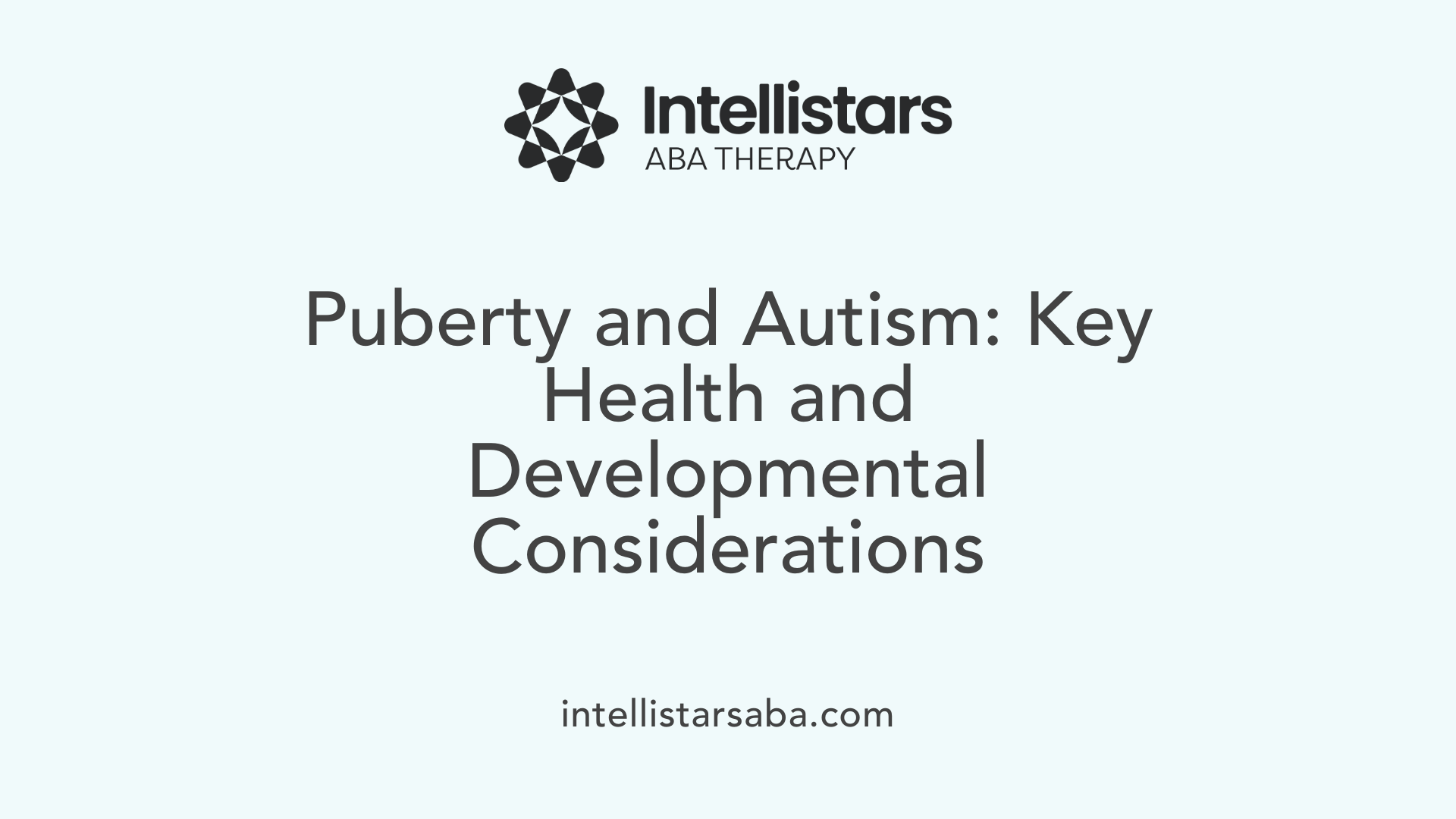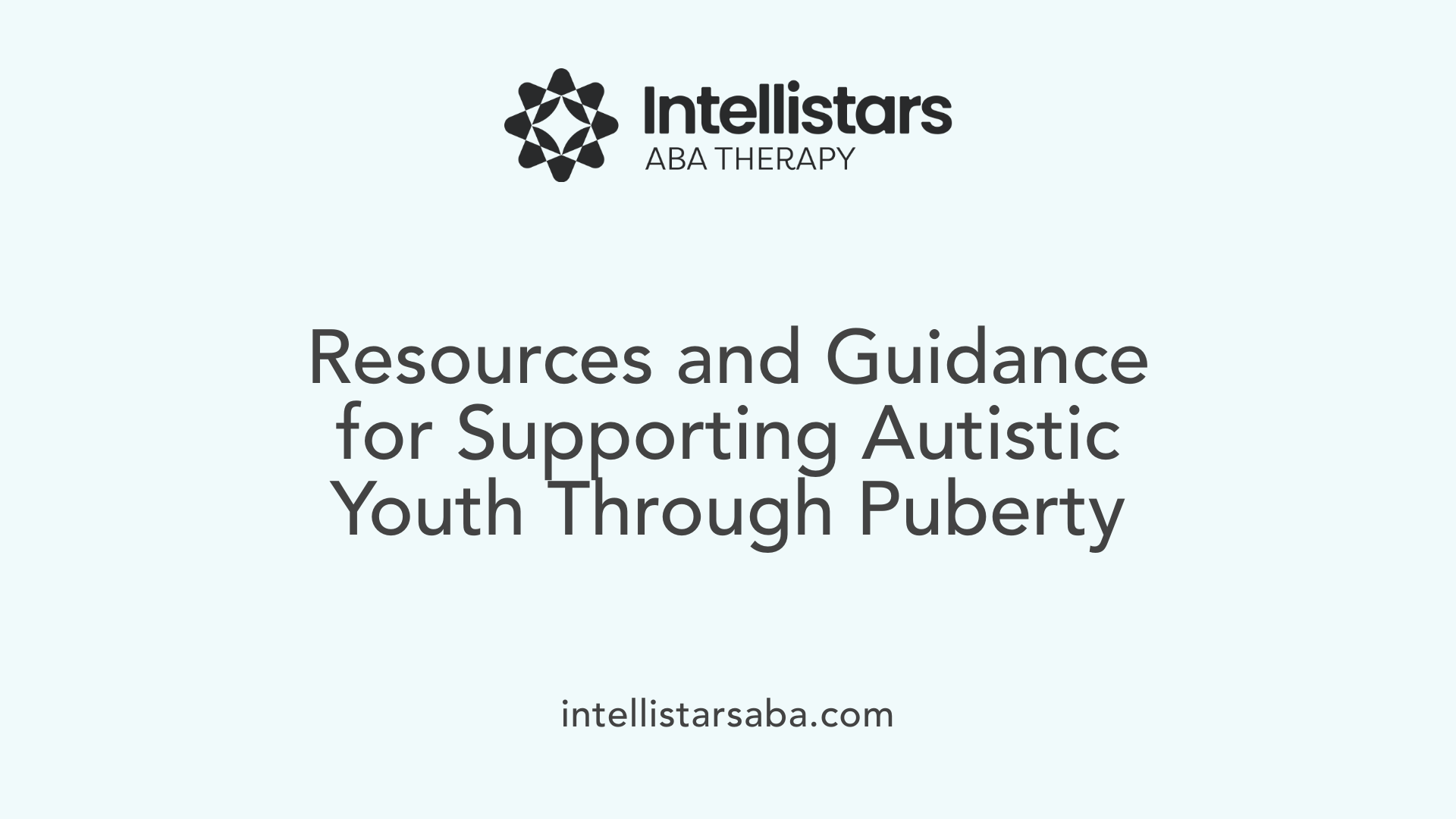Understanding the Unique Challenges of Puberty in Autistic Individuals
Puberty is a transformative phase that affects all adolescents, but for those on the autism spectrum, it brings unique physical, emotional, and social changes that require tailored understanding and support. This article explores the developmental processes, challenges, and strategies to help autistic youth navigate this critical life stage effectively.
Physical, Emotional, and Social Changes During Puberty in Autistic Individuals

What are the physical, emotional, and social changes that occur during puberty in autistic individuals?
Puberty marks a significant phase filled with numerous physical, emotional, and social transformations for autistic individuals. Understanding these changes can help caregivers, educators, and the individuals themselves navigate this transition smoothly.
Physically, children on the autism spectrum undergo the typical growth processes seen in neurotypical peers. These include growth spurts, development of secondary sexual characteristics such as breast development in girls and increased body hair in both sexes, and changes that affect body odors, voice deepening in boys, and menstruation in girls. Girls with autism often experience earlier breast development and earlier onset of menses compared to their neurotypical counterparts. Boys tend to follow a similar timeline to neurotypical boys. Visual aids like pictures or cartoons are highly effective in explaining these bodily changes in simple, direct language.
Emotionally, puberty can induce fluctuations such as mood swings, increased anxiety, and behaviors like aggression or property destruction. Hormonal surges influence emotional regulation, which can be especially challenging for those with autism who may have fewer natural coping strategies. Some individuals may develop feelings of sexual attraction or exhibit behaviors like masturbation, which require sensitive guidance to foster understanding of privacy and social appropriateness.
Social changes often involve heightened body awareness and shifts in social interactions. Adolescents may feel more socially isolated or withdraw due to difficulties interpreting social cues related to romantic interests or boundaries. They might also face challenges understanding the concept of private versus public behaviors, increasing the importance of early social skills training and clear, consistent rules.
Hormonal fluctuations can also trigger health-related issues, such as menstrual irregularities, cramps, or increased seizure activity, particularly in girls with epilepsy. These medical concerns necessitate close monitoring and tailored interventions.
Puberty is recognized as a 'window of opportunity' for social learning. It offers chances to build life skills like hygiene, safety awareness, and sexuality education. It is also a critical time to foster independence, cognitive and social development, while managing emotional health with strategies like Cognitive-Behavioral Therapy for those with better verbal skills.
Physical and social changes are intertwined with increased social awareness, desire for communication, and self-exploration. Supporting these developments involves collaboration with health professionals, educators, and therapists to develop personalized support plans.
Interestingly, research indicates that puberty may influence brain connectivity in individuals with autism, such as alterations in regions linked to social skills and behavioral regulation. These neurological changes could contribute to behavioral shifts during adolescence.
Overall, puberty presents both challenges and opportunities for autistic individuals. Early education using visual aids, clear language, and consistent support can foster better understanding, healthier social interactions, and emotional well-being.
| Change Type | Typical Signs | Specific Considerations | Support Strategies |
|---|---|---|---|
| Physical | Growth spurts, hair growth, body odor, voice deepening, menstruation | Girls may experience earlier development, hormonal irregularities | Use visual aids to explain body changes, reinforce hygiene rules |
| Emotional | Mood swings, increased anxiety, irritability | Increased risk of depression and behavioral challenges | Implement coping strategies, CBT, supportive interventions |
| Social | Greater body awareness, social withdrawal, boundary understanding | Difficulties interpreting social cues, managing privacy | Social stories, social skills training, consistent rules |
Understanding these interconnected changes helps in preparing autistic adolescents for this transformative stage, promoting resilience and independence.
The Challenges Faced by Autistic Adolescents During Puberty
What challenges do autistic adolescents face during puberty?
Puberty can be a particularly confusing and overwhelming time for adolescents on the autism spectrum. They often encounter a range of challenges that make this developmental phase more difficult than for neurotypical peers.
One significant challenge is the increase in sensory sensitivities. During puberty, hormonal surges can heighten sensitivities to sights, sounds, touch, and smells. For autistic teens, this can lead to sensory overload, difficulty focusing, and emotional outbursts. Emotional regulation becomes more complex as mood swings, frustration, and anxiety may intensify due to hormonal fluctuations.
Understanding and managing bodily changes such as menstruation in girls and wet dreams in boys require early education. Visual aids like social stories or charts can help explain these changes clearly and simply. Girls might experience irregular periods, cramps, or polycystic ovary syndrome, and behaviors like irritability or obsessive tendencies can increase during menstruation. Boys may face unpredictable erections, ejaculation, and wet dreams, which can be confusing or distressing if not properly prepared for.
Communication difficulties add another layer of complexity. Autistic adolescents often find it harder to interpret social cues or understand subtle signals related to romantic interests or social boundaries. This can lead to anxiety about social and romantic interactions and increases the risk of misunderstandings.
The social demands of romantic and sexual relationships can be daunting. Many teens on the spectrum may struggle with recognizing consent, privacy, and appropriate behaviors in different settings. Teaching these concepts proactively, with supportive visual tools and clear rules, is essential.
Mental health issues tend to be heightened during puberty. Anxiety, depression, and behavioral challenges often increase, sometimes resulting from sensory overload, social difficulties, or hormonal changes. Elevated cortisol levels, which are common among autistic children, can also contribute to these emotional challenges.
Safety concerns become particularly important. Increased irritability or aggression linked to hormonal changes can pose risks, making safety planning crucial. Monitoring online activity and teaching digital safety are also vital as adolescents become more socially active both offline and online.
School performance and social integration may decline temporarily during puberty. That’s why collaboration with teachers, therapists, and healthcare providers is necessary to create supportive environments. These professionals can help develop strategies to build self-esteem, manage frustrations, and adapt learning approaches.
Research indicates that brain connectivity patterns in autistic individuals may shift during puberty, affecting social brain networks and affecting social skills further. Changes at the neurobiological level can influence behavior and emotional responses.
Early intervention, tailored education, and ongoing support are vital in helping autistic adolescents navigate these challenges. With proper guidance, they can develop coping strategies and succeed in managing the physical and emotional changes of puberty.
Understanding these challenges allows caregivers and educators to prepare autistic teens more effectively, ensuring they transition through puberty with resilience and confidence.
Strategies and Support Options for Managing Puberty in Autistic Youth

What strategies and support options are available for managing puberty in children and adolescents with autism?
Supporting autistic children through puberty requires a proactive and individualized approach. Early conversations form the foundation, helping children familiarize themselves with the physical and emotional changes ahead. Using visual aids like pictures, social stories, and cartoons can make abstract concepts more concrete, reducing confusion and anxiety.
Parents and caregivers should introduce topics such as bodily functions, hygiene routines, and personal boundaries with simple, direct language. Reinforcing privacy concepts and appropriate public behaviors like masturbation helps children develop an understanding of social norms and personal safety.
To further support understanding, consistent use of visual tools—such as books about puberty and sexuality—can be highly effective. These resources allow children to process information at their own pace and in a non-threatening way. Repetition and routine are key, making sure core messages are clear and memorable.
Emotional regulation during puberty can be challenging due to hormonal surges and social changes. Support strategies involve validating feelings, teaching coping mechanisms like deep breathing or sensory breaks, and creating a safe environment for open communication.
Professional therapies such as Cognitive-Behavioral Therapy (CBT) and Applied Behavior Analysis (ABA) can help adolescents develop social and emotional skills. These therapies also assist in managing challenging behaviors, anxiety, and mood swings.
Monitoring behavioral and emotional changes is essential; signs like increased aggression or withdrawal may indicate stress or medical issues. Collaborating with educators and healthcare providers ensures consistent support across settings. Teachers and therapists can adapt teaching strategies to foster self-esteem, improve social skills, and accommodate sensory needs.
Supporting online safety is increasingly important. Teaching digital literacy and supervising online activities protect against potential risks and misconceptions. Building the adolescent’s confidence in managing relationships and understanding consent is vital.
Finally, comprehensive planning includes addressing future life skills such as hygiene, safety, social interactions, and vocational training. The goal is to empower autistic youth with independence and self-understanding, easing them through this transformative phase.
How do visual aids, teaching about boundaries, and collaboration support managing puberty?
Visual aids such as picture schedules, social stories, and informative books about puberty make it easier for autistic children to grasp complex concepts. These tools are especially useful because they cater to visual learning styles and help clarify expectations.
Teaching about personal boundaries and privacy fosters understanding of socially appropriate behavior. Clarifying the difference between private and public behaviors, including masturbation and social interactions, reduces confusion and aids social integration.
Collaboration with educators, therapists, and healthcare providers creates a cohesive support network. This teamwork ensures consistent messaging, adapts educational strategies, and addresses medical or behavioral challenges promptly. Regular communication among all parties helps tailor interventions that meet each child's evolving needs.
What are ways to support emotional regulation and manage challenging behaviors?
Teaching coping strategies such as relaxation techniques, sensory activities, and structured routines helps autistic adolescents manage emotional fluctuations during puberty. Recognizing early signs of distress allows caregivers to intervene proactively.
Providing outlets for expression—like drawing, writing, or physical activity—can alleviate frustration and reduce behaviors like aggression or self-injury. Validating feelings helps adolescents feel understood, fostering trust and openness.
Applying behavioral management plans established with professionals can address challenging behaviors safely. Consistent routines, positive reinforcement, and clear rules help create a predictable environment.
Monitoring mental health is crucial, as puberty can increase risks of anxiety, depression, and mood disorders. Regular check-ins, creating accessible communication channels, and seeking mental health support from specialists are vital components.
How can collaboration with educators and healthcare providers improve support?
Partnering with teachers and therapists ensures that support strategies are reinforced across all settings. Educators can modify curricula and classroom environments to accommodate sensory sensitivities and learning needs.
Medical professionals can assess hormonal or neurological factors influencing behaviors and emotional states. These assessments may lead to appropriate medical interventions or adjustments in therapies.
A coordinated plan that includes life skills training, social skills development, and health education enhances overall well-being. This teamwork maximizes the adolescent's chances of a successful transition through puberty, promoting independence, safety, and self-esteem.
Puberty-Specific Health and Developmental Considerations in Autism

What are the puberty-specific health issues and developmental considerations for autistic individuals?
Puberty introduces a range of physical and emotional changes that are often more challenging for children on the autism spectrum. These youth tend to experience earlier physical developments, especially in girls, who may encounter earlier breast growth and the onset of menses compared to their neurotypical peers.
Hormonal fluctuations play a significant role during puberty, with elevated testosterone levels observed in some autistic individuals of both genders. These hormonal influences can contribute to changes such as increased body and facial hair, voice deepening in boys, and irregular menstrual cycles in girls, sometimes accompanied by conditions like polycystic ovary syndrome (PCOS).
Autistic youth are at increased risk of various health problems during adolescence. Elevated or abnormal hormone levels, along with physical changes, can exacerbate behavioral issues, including increased aggression, anxiety, and depression. Sensory sensitivities often intensify, and many individuals struggle to understand or communicate their discomfort, making management of health issues more complex.
Furthermore, sleep disturbances become more common during puberty, negatively impacting mood and behavior. Increased emotional volatility, higher anxiety levels, and difficulties understanding social norms related to their bodies and sexuality can lead to confusion and increased vulnerability.
Autistic children also face risks related to physical health, such as obesity due to altered activity levels and dietary habits, and neurological considerations, with some research indicating a potential association between puberty and increased seizure activity in those with epilepsy.
Addressing these issues requires an integrated approach. Regular health monitoring, early education, and tailored communication strategies are essential. Visual aids, social stories, and step-by-step instructions help in preparing them for bodily changes and social expectations. Comprehensive planning involving families, healthcare providers, and educators ensures a supportive environment that fosters safety, health, and emotional stability.
Preventative and supportive strategies include teaching about menstruation and hygiene using visual tools, tracking cycles, and preparing for emotional shifts. For boys, clear explanations about erections, ejaculation, and wet dreams are essential for reducing anxiety around physiological changes.
Mental health needs should be prioritized, with early interventions for anxiety, depression, or behavioral challenges. Sleep hygiene routines, physical activity, and nutrition support overall health.
Autistic individuals also benefit from social and sexuality education tailored to their developmental level. This education covers understanding bodily autonomy, privacy, boundaries, and respectful relationships. Visual resources like social stories and books on puberty help clarify social norms about private versus public behaviors, including masturbation.
In conclusion, puberty for autistic individuals involves distinct health risks and developmental considerations. Proactive education, tailored communication, and continuous support from a multidisciplinary team ensure they navigate puberty with confidence, safety, and dignity.
The Impact of Puberty on Autism Development and Brain or Behavioral Changes

How does puberty impact autism development and related brain or behavioral changes?
Puberty plays a significant role in affecting individuals with autism, influencing their behavior, emotions, and social skills. During this period, hormonal surges, including increases in testosterone, estrogen, and cortisol, contribute to various physical and psychological changes. For autistic children, these hormonal shifts can intensify feelings of anxiety, depression, or behavioral challenges, making the teenage years more demanding.
Research has highlighted notable brain connectivity changes during puberty, especially in those with genetic vulnerabilities like chromosome 22q11.2 deletion syndrome. In these cases, brain networks tend to be hyperconnected before puberty and shift toward under-connectivity afterward. These changes can influence social cognition and behaviors associated with autism, affecting how adolescents interpret social cues and manage relationships.
A crucial concern is the earlier onset of puberty in autistic girls compared to neurotypical peers. This early pubertal development raises risks for mental health issues such as anxiety, depression, and even suicidal thoughts. It can also increase the likelihood of behavioral problems like aggression or obsessive behaviors related to hormonal fluctuations.
Hormonal fluctuations further complicate emotional regulation. Fluctuations in testosterone and cortisol can lead to mood swings, increased irritability, and feelings of frustration or distress. For many autistic adolescents, managing these emotional shifts can be overwhelming due to fewer natural coping mechanisms. These changes can also influence social interactions, sometimes resulting in withdrawal or difficulty understanding social norms.
Studies on genetic conditions like chromosome 22q11.2 deletion syndrome reveal that brain connectivity patterns are altered dramatically across puberty. Before puberty, these brains tend to be hyperconnected, potentially contributing to autism traits, but become underconnected after puberty, which may affect social skills and emotional regulation. This dynamic suggests that puberty can be a critical window where brain development either mitigates or exacerbates autism-related behaviors.
Overall, puberty introduces complex biological, emotional, and social challenges for autistic individuals. Early identification of these changes, along with tailored support—including behavioral therapies, hormonal assessments, and social skills training—is essential. Understanding these neurodevelopmental shifts helps caregivers and professionals provide better support during this transformative phase.
| Aspect | Changes During Puberty | Impact on Autistic Youth | Supporting Strategies |
|---|---|---|---|
| Brain Connectivity | Transition from hyperconnectivity to under-connectivity in some cases | Alters social and emotional processing capabilities | Cognitive-Behavioral Therapy, social skills groups |
| Hormonal Fluctuations | Increased testosterone, estrogen, cortisol | Mood swings, increased behavioral challenges | Hormonal assessments, behavioral interventions |
| Pubertal Timing | Earlier in girls, similar in boys | Increased risk of mental health issues and behavioral problems | Early puberty education, mental health support |
| Behavioral and Emotional Changes | Emotional volatility, increased anxiety, withdrawal | Heightened behavioral issues, difficulty managing social interactions | Therapy, social stories, visual aids, routine adjustments |
| Brain Development | Shifts in brain connectivity, synaptic changes | Affects social cognition, adaptation, and learning | Multidisciplinary support, neurodevelopmental monitoring |
These developments highlight the importance of a proactive approach, including early education about bodily changes, emotional regulation strategies, and ongoing support for physical and mental health challenges during adolescence for those on the spectrum.
Guidance and Resources for Supporting Autistic Youth During Puberty

What guidance and resources are available for parents, caregivers, and professionals supporting autistic youth through puberty?
Supporting autistic children through puberty requires a well-rounded approach combining education, therapy, and community support. Numerous resources are available to help guide these efforts.
Organizations such as the Autism Treatment Network supported by Autism Speaks provide comprehensive materials and programs tailored to autism. These resources cover a wide range of topics, including physical changes, emotional regulation, social skills, and sexual health. They often include detailed guidelines for caregivers and educators to facilitate understanding and open conversations.
Educational programs specifically designed for autistic youth focus on teaching body awareness, boundaries, privacy, and appropriate social behaviors. Therapy options such as Cognitive-Behavioral Therapy (CBT) are effective in managing anxiety, mood swings, and behavioral challenges often associated with puberty. Support groups and peer networks also play a vital role in providing emotional support and sharing effective strategies.
Early intervention is critical. Starting discussions about bodily changes, sexuality, identity, and safety before puberty begins can reduce fears and confusion. Visual aids like social stories, pictures, videos, and diagrams help children grasp complex topics in a straightforward manner.
Professional healthcare providers, including pediatricians familiar with autism, can assist in medical management of hormonal changes, menstrual issues, and mental health concerns. Collaboration with educators and therapists ensures a consistent approach across home, school, and community settings.
Legal and financial planning should also be part of support strategies. Planning for guardianship, long-term care, and vocational training prepares autistic youth for greater independence and security.
Most importantly, fostering an environment of open communication, patience, and understanding helps autistic children navigate the overwhelming changes of puberty confidently.
Visual aids, social stories, and support from healthcare providers
Using visual supports enhances comprehension for autistic youth. Social stories crafted around puberty topics, like hygiene, boundaries, and safety, clarify expectations and social norms.
Healthcare providers play a crucial role in monitoring hormonal health, managing medication, and addressing mental health issues such as anxiety and depression.
Regular check-ins and therapy sessions can be tailored to each child's needs, reinforcing understanding and emotional resilience.
Legal, financial, and vocational considerations
Starting legal and financial planning early ensures that autistic individuals are supported throughout their lives. This includes guardianship arrangements, financial guardianship, and decision-making capacity.
Vocational planning around ages 14-16 prepares adolescents for employment and independent living. Education about life skills, safety awareness, and social opportunities should be integrated into early preparation.
Having a structured plan for post-secondary education or employment, along with health management, contributes to a successful transition into adulthood.
| Topic | Details | Additional Notes |
|---|---|---|
| Educational Resources | Social stories, visual aids, books, guides | Emphasize concrete, visual, and repetitive teaching methods |
| Therapy Options | CBT, behavioral programs, social skills training | Tailored to developmental level and individual needs |
| Support Groups | Peer groups, family networks | Promote shared experiences and emotional support |
| Medical Management | Hormonal and mental health monitoring | Collaboration with specialists is essential |
| Legal & Financial Planning | Guardianship, savings, long-term care planning | Early planning ensures rights and security for future needs |
| Vocational and Life Skills | Job training, independence skills | Focus on real-world applications and gradual skill-building |
This comprehensive approach aims to create a supportive framework that addresses the physical, emotional, social, and practical aspects of puberty for autistic youth. Equipping parents, caregivers, and professionals with these tools and resources helps foster positive development and well-being during this pivotal life stage.
Supporting Autistic Youth Through Puberty: A Collective Effort
Navigating puberty is a multifaceted journey that requires understanding, proactive planning, and collaboration among families, educators, healthcare providers, and support organizations. Recognizing the physical, emotional, and social changes that autistic adolescents face ensures they are equipped with the knowledge and skills to manage this critical period confidently. Early education, tailored interventions, and supportive environments not only mitigate potential difficulties but also promote resilience, independence, and healthy social and emotional development. With the right resources and compassionate guidance, autistic youth can navigate puberty successfully, laying a strong foundation for their transition into adulthood.
References
- Autism and Puberty
- Autism and puberty
- Understanding and Supporting Puberty in Autistic Girls and ...
- The Association between Autism Spectrum Disorder and ...
- Autism and risk of precocious puberty: A cohort study ...
- Lurie Center for Autism: Puberty
- Puberty triggers brain rewiring in genetic condition tied to ...






